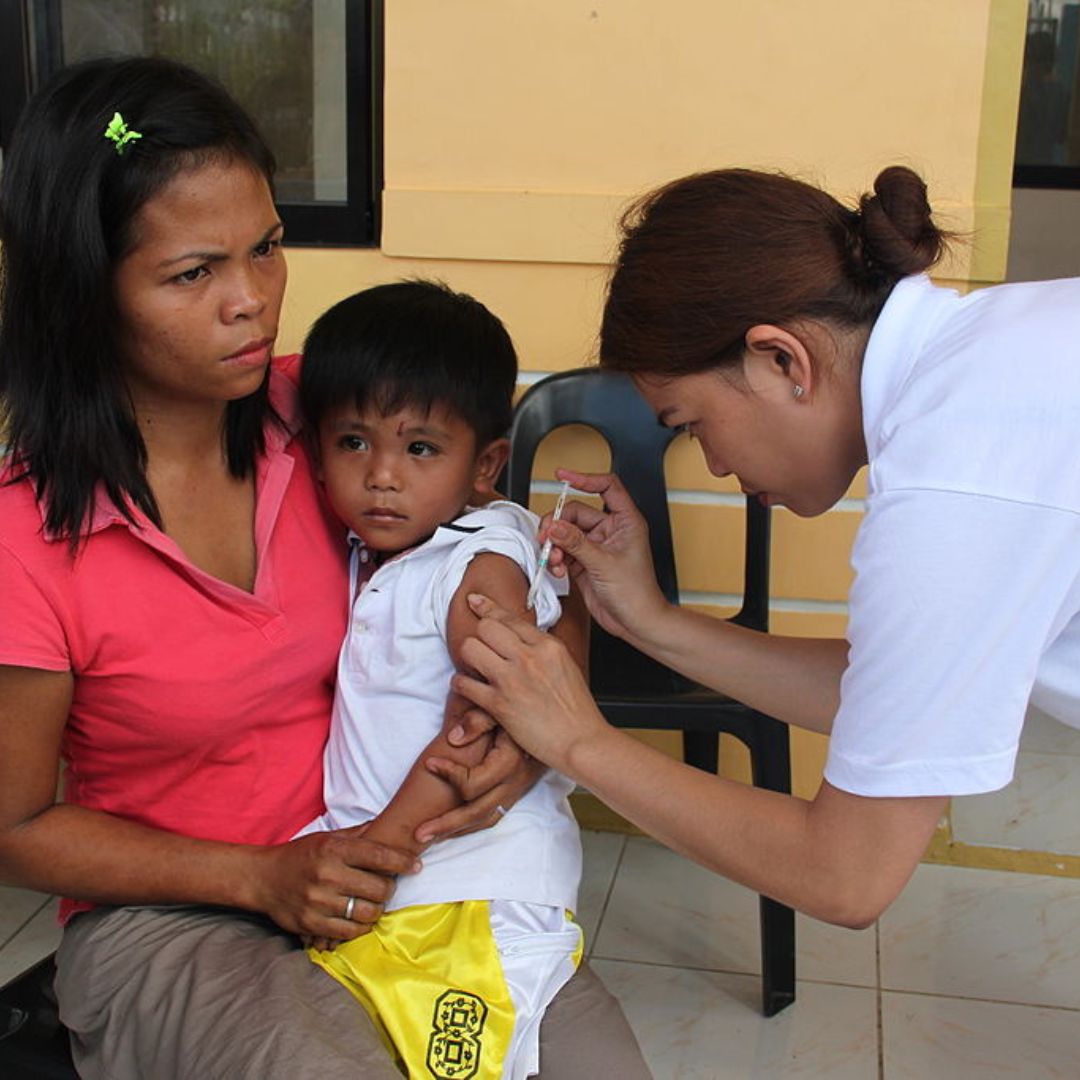
Image Credits: Wikipedia (Representational)
Others/World
Here's Why World's First Malaria Vaccine Won't Reach Millions Of Children Who Need It
 |
|Efforts are falling short, with a lack of funding and commercial potential thwarting British-based pharmaceutical company GSK Plc's capacity to produce as many doses of its shot as needed.
After decades of work, the World Health Organisation (WHO) endorsed the first-ever malaria vaccine in 2021, a historic milestone that promised to drive back a disease that kills a child every minute.
In reality, efforts are falling short, with a lack of funding and commercial potential thwarting British-based pharmaceutical company GSK Plc's capacity to produce as many doses of its shot as needed.
The British drugmaker committed to producing nearly 15 million doses annually through 2028, following 2019 pilot programmes, considerably less than the WHO states is needed. Currently, it is unlikely to make more than a few million every year before 2026, NDTV quoted a Reuters report.
According to a GSK spokesperson, it could not make enough of its vaccine Mosquirix to meet the considerable demand without more funds from international donors, without giving details on the number of doses expected to produce annually in the first years of the rollout.
"Demand over the next five to 10 years will probably outstrip the present forecasts on supply," Thomas Breuer, GSK's chief global health officer, said.
The vaccine's effectiveness at preventing severe malaria cases in children is relatively low, at around 30 per cent in a large-scale clinical trial. Some officials and donors hope that a second shot tested by Oxford University may prove better, easier and cheaper to produce in bulk.
Yet the world's inability to fund more Mosquirix shots concerns many in Africa. Kids on the continent account for the vast majority of the roughly 600,000 global malaria deaths yearly.
"Mosquirix can save many precious lives before another new vaccine comes," said Kwame Amponsa-Achiano, a public health specialist leading a pilot vaccination programme in Ghana. "The more we wait, the more kids die needlessly."
The limited international appetite to produce and distribute more Mosquirix stands in sharp contrast to the record speed and funds with which wealthy nations secured vaccines for COVID-19, a disease that poses relatively little risk to children.
No Significant Market For Malaria Vaccine
Unlike many pharmaceutical products, there is no significant market for a malaria vaccine in the developed world, where drug companies typically make enormous profits that allow them to make their products available at lower prices in low-income countries.
"This is a disease of the poor, so it's not been that appealing in terms of the market," said Corine Karema, chief executive of the nonprofit RBM Partnership to End Malaria, which is working with African governments to eliminate it.
"But one child dies of malaria every minute, it's unacceptable."
In the coming weeks, health organisations worldwide will announce the following steps to make Mosquirix largely available, including the first procurement deal and the WHO's recommended allocation to prioritise nearly 10 million children at the highest risk.
Long-term, WHO officials say nearly 100 million doses a year of the four-dose vaccine will be required, covering around 25 million children. When the U. agency backed Mosquirix in October 2021, it said that even a little supply might save 40,000 to 80,000 lives annually, without specifying the required doses.
GSK's maximum target of 15 million doses might prevent nearly 20,000 deaths yearly.
Hitting Desired Target May Take Years
According to several officials at the WHO, hitting 15 million could take years, and a wider distribution beyond the pilot nations was unlikely before early 2024. Even then, it would begin slowly.
In addition, GSK has to upgrade its manufacturing capacity to reach its target. It stated it had set up a funding deal with the international vaccine alliance Gavi to help stockpile a vital ingredient of the shot to ensure there was no gap in supply during the process.
The drugmaker has invested 700 million pounds in the vaccine's development and said it won't charge more than five per cent above the cost to produce it.
"No company wants to be in a scenario where you build manufacturing which oversupplies the market and vaccines remain unused," said Breuer said.
After 2028, Bharat Biotech will take over the production of Mosquirix's key ingredient.
GSK's Breuer expects the deal with the company to accelerate production. The British drugmaker will continue to produce the adjuvant, immune-boosting portion of the vaccine and is committed to doubling production to 30 million doses in a year without offering a timeline.
Losing Someone To Malaria
The company has donated 10 million doses to pilot programmes in Ghana, Kenya and Malawi, and less than half have been shipped. The countries plan to expand campaigns in 2022 and use a mix of the remaining donations and purchased shots.
GSK stated a WHO decision to collect additional data on safety and effectiveness from the pilot programmes had added many years to the launch process, during which it had to idle a dedicated production facility. According to WHO, safety questions had to be addressed before approval, and it worked urgently to increase supply.
Mary Hamel, the agency's malaria vaccine implementation head, said COVID-19 vaccines had shown how rapidly things could move with the political will and funding. Mosquirix has been developing since the 1980s, partly because of the complexity of targeting the malaria parasite.
Also, its regulatory pathway has been slow. In 2015, GSK published results from a large-scale clinical trial showing vaccines reduced the risk of severe malaria by nearly 30 per cent. The WHO sought more detail on the shot's safety and effectiveness, gathering information from 2019 during the pilot vaccination programmes, before endorsing Mosquirix.
In the past, such real-world data on a vaccine has been tracked often after it has been authorised for use.
Now recommended for use, it is unclear how the shot's distribution will be financed for long. Funding for malaria totalled $3.3 billion in 2020, less than 50 per cent of the estimated need for tools like treatments, insecticides and bed nets.
Adding malaria vaccines might cost between $325 million and over $600 million yearly, depending on how large they are used. The WHO estimates that the GSK vaccine will cost nearly $5 per dose.
The Gates Foundation stated it would continue to back research into the best use of the "historic" vaccine, but "concerns about the relatively low efficacy, constrained supply challenges and short duration" meant it would not fund deployment.
Gavi is currently the only significant funding source for a wider Mosquirix rollout. It approved about $155 million for 2022 through 2025, alongside some funding from the countries. Internal documents suggest Gavi's investment in the first year is only expected to be $20 million.
Oxford Shot In The Works
Several global health officials said that future funding from donors might be better committed to a new shot from Oxford University scientists, who developed AstraZeneca's COVID vaccine.
Data from small trials revealed 77 per cent efficacy over 12 months if given to babies shortly prior to the peak malaria season. Results from a much larger clinical trial are expected in the next few weeks. Some researchers suggest the GSK vaccine may also show higher effectiveness if given seasonally.
The Serum Institute of India, which will manufacture the vaccine, said it expects to make around 200 million doses every year by the end of 2024.
In the following years, there are also chances for a shot being developed by BioNTech, using the same mRNA technology as their successful COVID vaccine made with Pfizer.
But in the years before either of those shots might be used, there will not be enough vaccines for 10 million children who are most at risk.
Also Read: Gender Pay Gap: Women In Health Sector Earn 24% Less Than Men, Finds Report